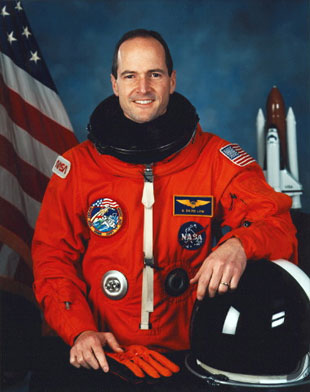March 17, 2008 — A former NASA astronaut who first joined the space agency to work on interplanetary probes and who later led a commercial effort to launch supplies to the International Space Station, G. David Low died on Saturday at age 52 as a result of a chronic illness.
Selected to be an astronaut in May 1984, Low first went to work for NASA four years earlier at the Jet Propulsion Laboratory in Pasadena, Calif. There, he contributed to the systems design for the 1989-2003 Galileo mission to Jupiter, prior to his role as principal spacecraft systems engineer for the Mars Geoscience/Climatology Observer.
Low made his first flight to space in 1990, after holding a variety of technical assignments including work on the shuttle's robotic arm, extravehicular activity (EVA, better known as spacewalking) and orbiter checkout tests at the Kennedy Space Center in Florida. He also served as the spacecraft communicator, Capcom, in Houston Mission Control during several flights, including the return to flight after the loss of space shuttle Challenger in 1986.
Launching on Columbia for an 11-day mission, Low flew as a mission specialist aboard STS-32. He and his crew mates deployed a defense communications satellite and retrieved the Long Duration Exposure Facility (LDEF), a school bus-sized cylindrical experiment rack that tested a variety of materials over the course of nearly six years exposed to the vacuum of space. The crew filmed their activities with an IMAX camera, which later appeared in the large-format film "Destiny in Space" released in 1994.
Low's second mission, STS-43, came a year later aboard Atlantis. Serving as flight engineer, Low assisted with the launch of the fifth Tracking and Data Relay Satellite and took part in conducting over 30 experiments related to the planning for the future space station.
Low's third and final flight also included his first and only spacewalk. During Endeavour's 10-day STS-57 mission in June 1993, the crew retrieved EURECA, the European free-flying spacecraft, and conducted experiments inside the first flight of the Spacehab module. Four days into the mission, Low and Peter Wisoff donned spacesuits and exited outside the orbiter for a five hour, 50 minute EVA. The two spacewalkers stowed the European Retrievable Carrier in Endeavour's payload bay and tested techniques applicable to servicing the Hubble Space Telescope on a future mission.
In total, Low logged nearly a month in space while circling the earth more than 540 times.

Low continued working for NASA for three years after his last flight, serving on the Russian Integration Team that defined changes between Space Station Freedom and the International Space Station (ISS) programs. He later led the EVA Integration and Operations Office and assisted the NASA Legislative Affairs Office, where he worked to inform members of Congress about developments within the space program.
Low left NASA in February 1996 to join Orbital Sciences Corporation in Dulles, Virginia. Hired as Vice President of Safety and Mission Assurance for the company's Launch Systems Group, Low went on to serve as Vice President of Orbital's Advanced Programs Group and in 2004, of the Technical Services Division.
In 2006, Orbital announced Low's promotion to Senior Vice President and Program Manager for the Commercial Orbital Transportation Services (COTS) program. In his new role, Low oversaw the company's development of a commercial resupply launch system to service the space station. He was still serving in this position when he died.
Born February 19, 1956, in Cleveland, Ohio, Low's father, George M. Low was an Apollo program manager and the deputy administrator of NASA. He earned a bachelor of science in physics-engineering from Washington and Lee University, a B.S. in mechanical engineering from Cornell University, a masters in aeronautics and astronautics from Stanford, and an masters of business administration from Johns Hopkins University. He also completed the Advanced Management Program at the Harvard School of Business.
Low received the NASA Outstanding Leadership Medal, the NASA Exceptional Service Medal and three NASA Space Flight Medals. He was also awarded an honorary Doctor of Engineering from Rensselaer Polytechnic Inst.
He is survived by his wife JoAnn and their three children.
